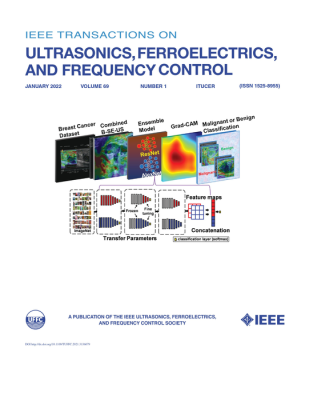
The study published as the front-page cover paper of the January issue of IEEE Transactions on Ultrasonics, Ferroelectrics, and Frequency Control. Image courtesy of POSTECH
February 4, 2022 — A new diagnostic tool for breast cancer that combines two ultrasounds has been developed. A POSTECH research team led by Professor Chulhong Kim (belonging to the Department of Convergence IT Engineering, Electrical Engineering, and Mechanical Engineering), and Misra Sampa (Department of Convergence IT Engineering) has developed a breast cancer detecting deep learning model that combines grayscale B-mode and strain elastography (SE) ultrasound imaging.
Ultrasound imaging is not only considerably safer and less costly than other diagnostic methods – such as mammography, X-ray, or MRIs – but also enables in-depth observation of the tissues. Among them, the grayscale B-mode ultrasound that clearly shows the lesion structure and the strain elastography ultrasound that shows the tumor density are widely used for breast cancer classification. To this, Professor Kim’s team combined the two to maximize their strengths.
The study was conducted on 85 breast cancer patients including 42 with benign lesions and 43 with malignancies, all confirmed by biopsy. Two deep neural network models, AlexNet and ResNet, were separately trained on combined 205 grayscale and SE images from 67 patients with benign and malignant lesions.
The two deep learning models were then configured to work as an ensemble, and tested on a dataset of 56 images from the remaining 18 patients. This deep learning ensemble model identified diverse features present in the two different ultrasound images, and successfully detected the presence of malignant tumors.
The experimental results demonstrate that the accuracy of the deep learning ensemble model is 90%, which is higher than the individual models (84% each), and the model trained using grayscale B-mode or SE imaging (grayscale 77%, SE 85%) alone. In particular, while the individual model misclassified five patients, whereas the ensemble model only missed two.
Until now, ultrasound imaging was used in breast cancer classification but suffered from a shortage of radiologists and poor imaging quality. The deep learning model developed in this study enhances the accuracy of breast cancer diagnosis.
“Using this deep learning model can achieve superior detection efficiency since it can accurately classify breast cancers in ultrasound images,” explained Professor Chulhong Kim who led the study.
Featured as the front cover paper of IEEE Transactions on Ultrasonics, Ferroelectrics, and Frequency Control, an international journal on ultrasound imaging, the study was conducted with the support from the Ministry of Education, Ministry of Science and ICT, and Ministry of Trade, Industry, and Energy of Korea.
For more information: http://international.postech.ac.kr/
Related POCUS Content:
VIDEO: Imaging COVID-19 With Point-of-Care Ultrasound (POCUS)
Utility of Point-of-Care Ultrasound Across Clinical Applications Spurs Continued Growth


 December 08, 2025
December 08, 2025 









